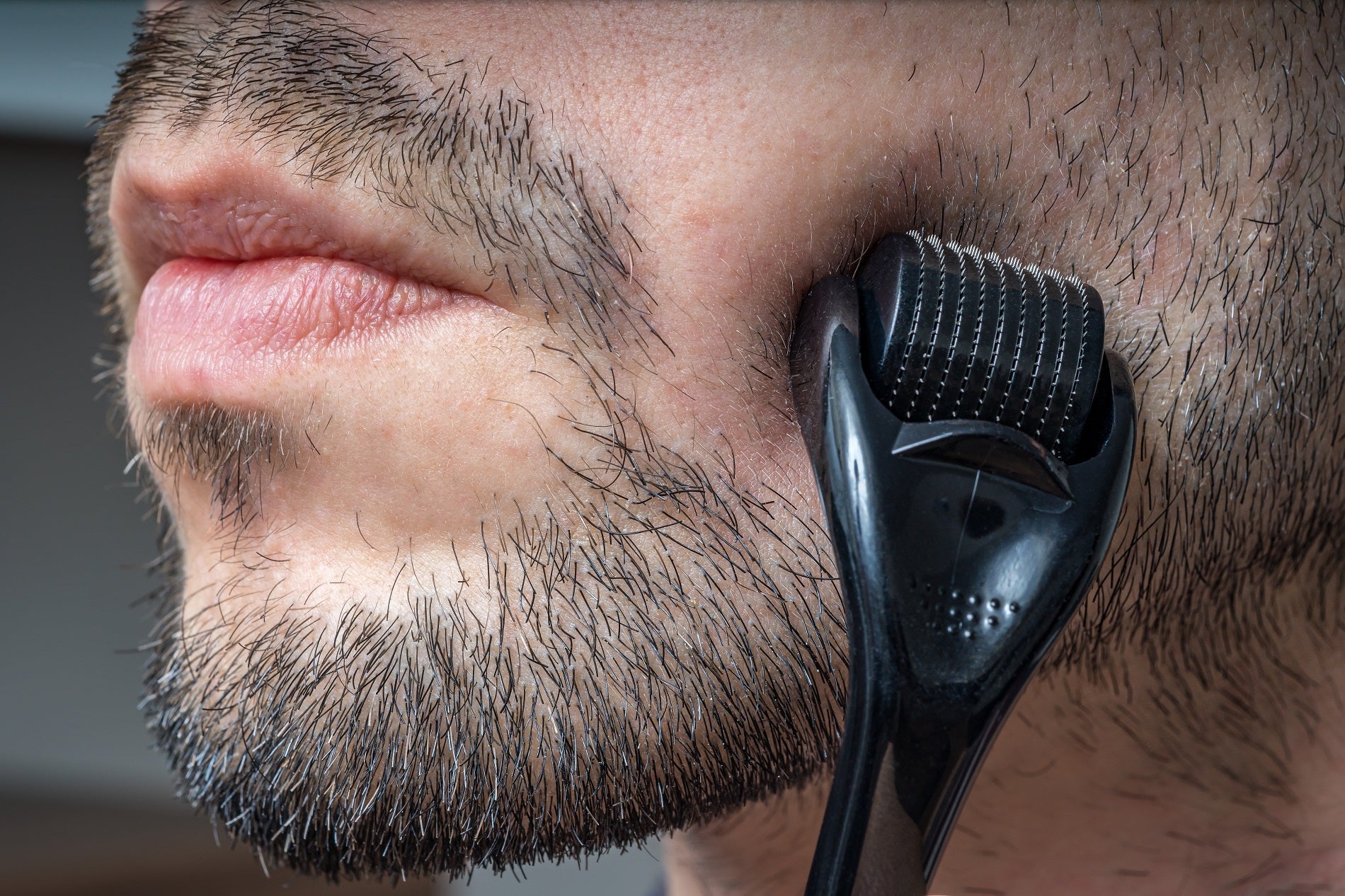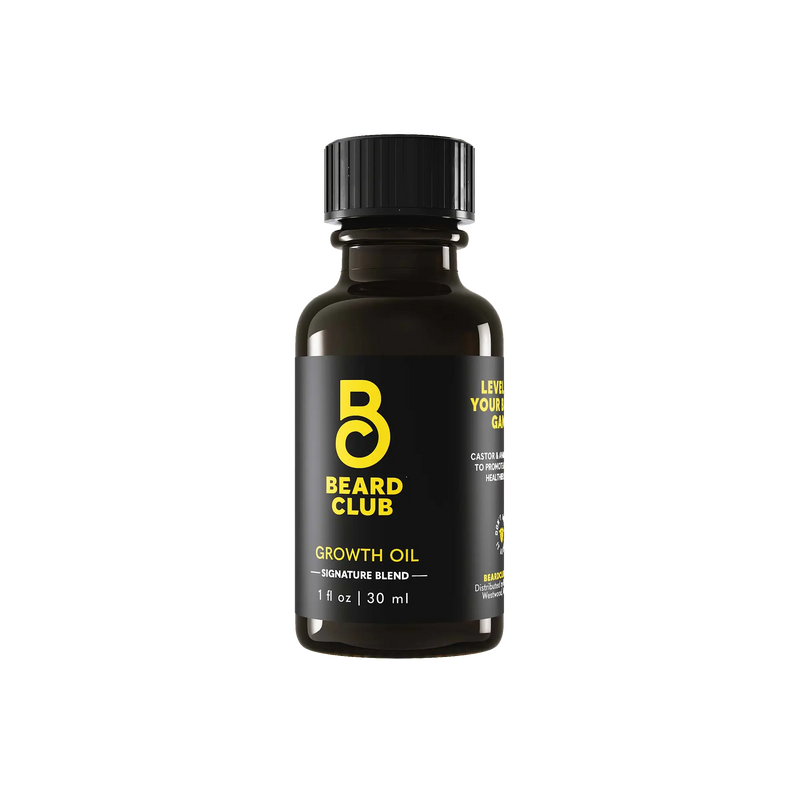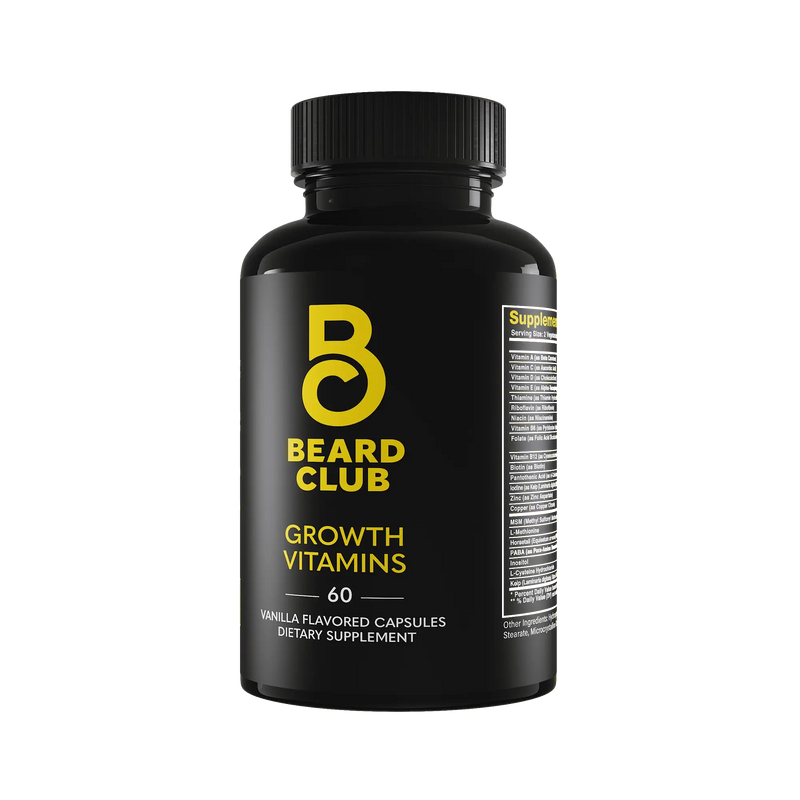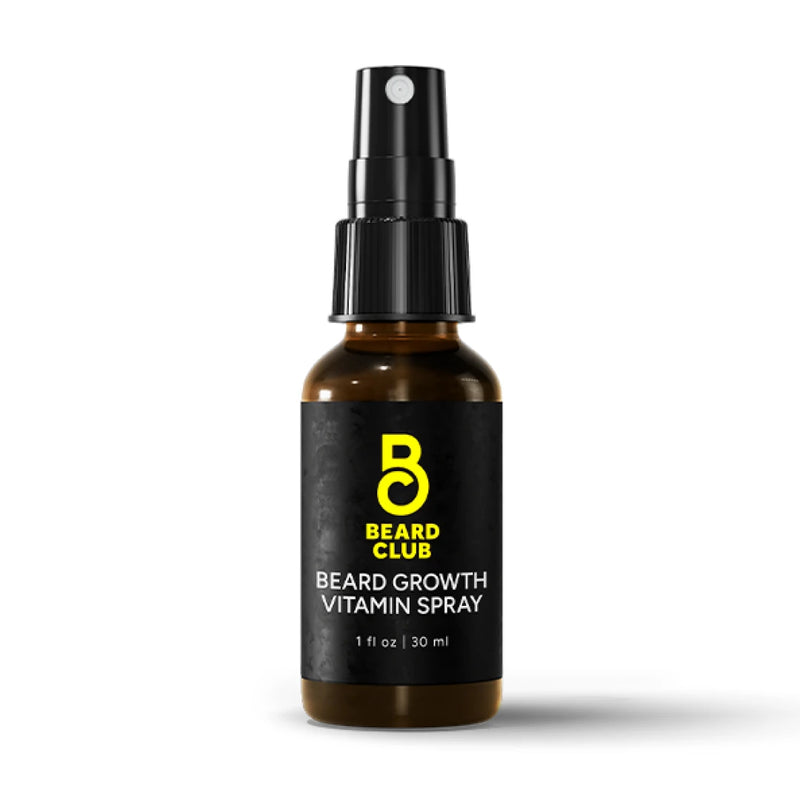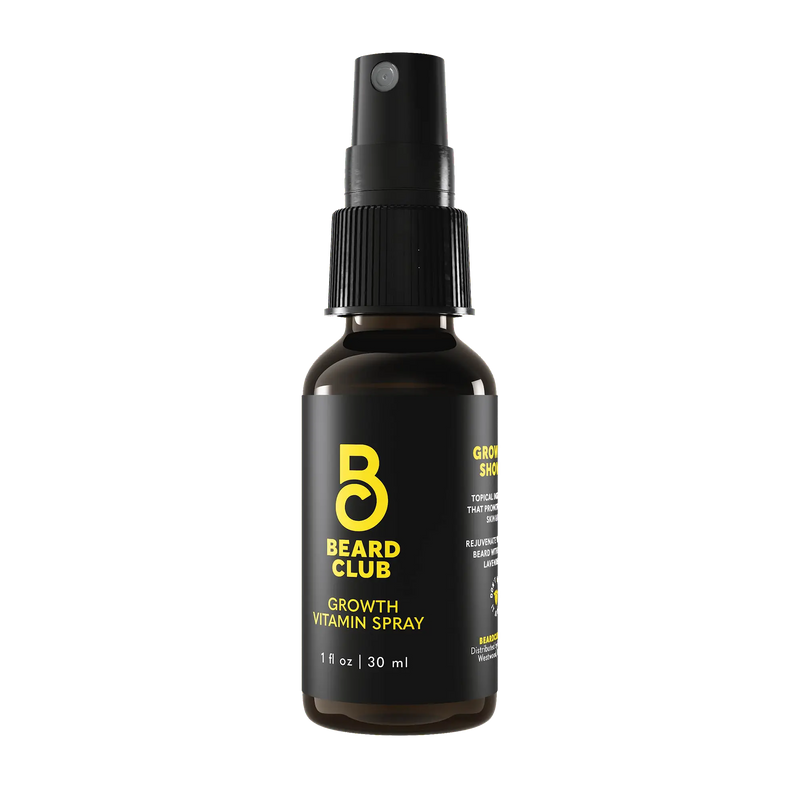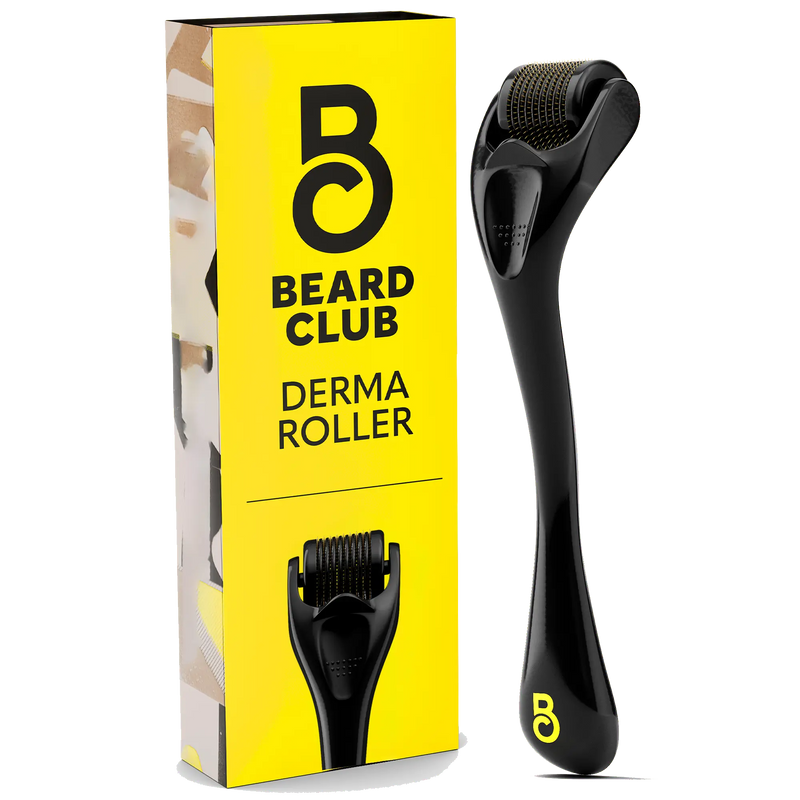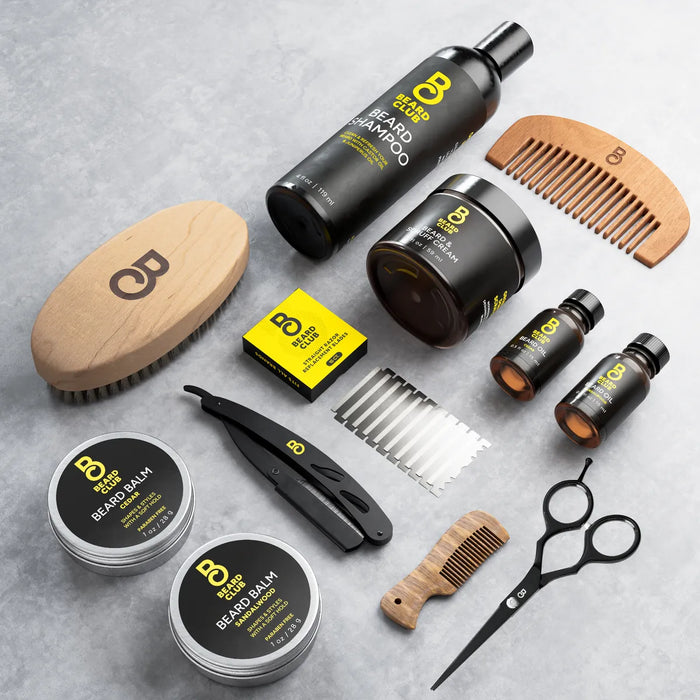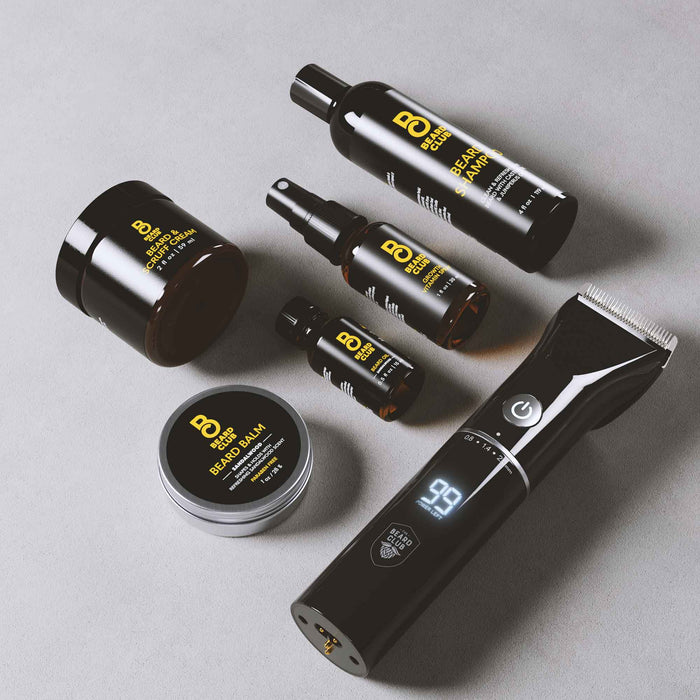How to Use a Derma Roller for Beard Hair: A Step-By-Step Guide
We’ve all been there—you’ve tried everything you could think of to stimulate your beard growth, but you’re still not getting the results you want.
If it’s time to try something new in your beard routine, you might be considering a beard roller. But unless you’re a skincare guru or a dermatologist in training, you might not be familiar with this tool.
In this guide, we’re going to cover everything you need to know about how to use a beard derma roller. We’ll explore why you should consider derma rolling, how to do it, mistakes to avoid, and how to handle potential skin irritation.
For patchy beards or slow growers, the derma roller could provide a long-term solution to your beardly woes.
What is a Derma Roller, and Why Use One?
While it might look like a miniature version of a medieval torture device, a derma roller isn’t as intimidating as it seems.
Derma rolling—also called micro-needling—harnesses the power of tiny needles to stimulate skin repair and, yes, hair growth.1 The device contains a small cylindrical drum covered in small needles, which users roll across their skin to create tiny pinpricks.
 Why would you subject yourself to such a practice? Well, when you create these micro wounds on the surface of your skin, you stimulate the skin’s healing response—transporting blood, collagen, and elastin to the wounded area, providing a healthy foundation for future hair growth.
Why would you subject yourself to such a practice? Well, when you create these micro wounds on the surface of your skin, you stimulate the skin’s healing response—transporting blood, collagen, and elastin to the wounded area, providing a healthy foundation for future hair growth.
While you may be wondering how to use a derma roller for beard hair growth, you might also have another valid question—do derma rollers work? The short answer? Yes:
- Dermatologists and plastic surgeons have been using micro-needling since the late 1990s to stimulate scar repair.
- Derma rolling can enhance the delivery of topical skin products—beard products included. It punctures the top layer of the skin, increasing the potential for absorption.
- In a study of alopecia patients, those using a combination of micro-needling and Minoxidil (one of the most potent hair follicle activators) achieved significantly greater hair growth than patients using Minoxidil alone.
The facts don’t lie—derma rolling can improve the health and appearance of skin and help stimulate new hair growth. If you struggle with some of the more common beard growth issues like a patchy beard or slow growth, derma rolling is certainly worth a shot.
How to Use a Beard Derma Roller
You came here for answers—if you arrived here by Googling “how to use derma roller for beard growth,” you’ve come to the right place. Let’s dive into the nitty-gritty of micro-needling.
#1 Be Prepared
Slow your roll—you’ll have to do some prep work before going to town on your unsuspecting epidermis:
Clean up your beard – If you have to do any beard trimming, do it before you start the micro-needling process to keep hairs and dead skin from clogging your pin prick wounds.
Clean your derma roller – To prevent infections and injuries, you must clean your beard roller before use. When it comes down to how to clean a derma roller, soak the roller in isopropyl alcohol and wipe down the handle with an alcohol-soaked cotton ball beforehand. Follow up with a disinfecting derma roller cleansing spray to further ensure cleanliness.
Clean yourself – Micro-needling can be a bit like getting a tattoo—your skin should be as clean as possible before you create an open wound (no matter how small). Cleanse your face with beard and face wash, and clean your hands with soap and warm water for at least 20 seconds before handling your roller.
If you plan to apply any topical beard products after your micro-needling treatment, make sure your products are within arm’s reach and ready for application.
If it’s your first time wielding the derma roller, keep a few clean paper towels at the ready. If you start to draw blood, you should stop the process and disinfect the bleeding area right away (more on bleeding below).
#2 How to Derma Roll Your Beard
Once your face and hands are clean, your derma roller is disinfected, and your post-roll products are ready, it’s time to start rolling your beard. If you keep the following tips in mind, you can’t go wrong:
Be Gentle: You should be applying very light pressure to your skin. If you’re in significant pain, ease up a bit. Remember that you’re not trying to penetrate the first layer of skin—you’re just making micro pricks.
How to Roll: As you derma roll, work in sections. You can roll horizontally, vertically, or diagonally (different angles might work better for different areas of your face). Choose an area, roll the tool back and forth five times, and move on to a new section. Over-rolling could lead to irritation, so err on the side of caution.
How to Avoid Tangles: People with longer beards may be scratching their heads—how are you supposed to use this without snagging your hard-earned beard hairs? Instead of rolling back and forth, roll in the direction of your facial hair growth only, picking up the roller and moving it back to your starting position to prevent snags and tangles.
Be Patient: Your beard isn’t going to start sprouting right before your eyes while you micro-needle. As part of your regular beard care routine, maintain a consistent, regular derma rolling schedule to promote collagen production and blood flow, which can in turn support long-term facial hair growth and healthy skin.
#3 Post-Roll TLC
After you’ve done your derma roller, it’s time for clean-up.
First, clean yourself:
- Examine your skin to make sure you aren’t bleeding
- If you are bleeding, disinfect the area.
- Wash your face again, and pat dry it with a fresh hand towel
- Apply your desired skin and beard care products, such as a beard growth oil or beard growth vitamin spray. Be sure to caution on product use if you are experiencing irritation or bleeding.
If you’re using multiple products, remember to apply them in an order that will ensure their effectiveness:
- Apply your skin-specific products first, in the following order
- Prescription or medicated products should be applied first
- Moisturizers and sunscreen should sit atop medicated products
- Makeup or tinted products should be applied last
- After applying skin products, apply any desired beard products, such as a nourishing beard oil
While dermatologists recommend derma rolling as part of your nighttime routine, it’s crucial that you use an SPF product if you opt for a morning micro-needle. The mini indentations create additional surface area for UV ray penetration, increasing your risk of sun exposure damage.
After you’re done primping, clean up your workspace. We recommend rinsing your derma roller once more to disinfect before storing it in a case, like the one that comes with The Beard Club’s Beard Roller, to prevent collection of dust or bacteria.
You should treat your derma roller with as much care as you give your toothbrush—if not more. Don’t share your roller with someone else, and always store it in a clean and dry location.
How Often Should You Derma Roll?
Establishing the right frequency for use is the key to maximizing the benefits of derma rolling while minimizing potential side effects. Understanding the frequency of micro-needling can be particularly important for newcomers and those with sensitive skin to ensure a positive experience.
Starting Slowly
Initially, it’s advisable to start with a conservative approach — derma roll once a week. This gives your skin time to adjust to the new treatment and allows you to monitor how your skin reacts without overwhelming it. During this phase, observe any changes or improvements in your skin tone and texture, including the reduction of fine lines and hyperpigmentation.
Assessing Skin Response
As your skin acclimatizes to derma rolling, you can gradually increase the frequency. For most, rolling twice a week is optimal, enhancing collagen and elastin production without over-stressing the skin cells. This frequency is generally sufficient to stimulate hair regrowth and support skin renewal, contributing to a healthier beard and skin appearance.
Choosing the Right Tools: What Size Needles for Beard Rollers?
The needle length and derma roller size play a significant role in how your skin might react. Shorter needles (around 0.25mm to 0.5mm) are ideal for beginners and those with sensitive skin, as they minimize discomfort and are less likely to irritate. However, you’ll often see derma rollers with titanium coated .3mm needles.
All of these needle sizes are excellent for promoting product absorption — like hydrating serums containing hyaluronic acid or rejuvenating formulas with vitamin C — without penetrating too deeply.
Incorporating Supportive Skincare
To enhance the healing process and optimize results, integrate a soothing beard moisturizer or beard cream into your skincare routine post-session. These products can help hydrate the skin and soothe any temporary redness or discomfort, ensuring the skin remains calm and nourished.
Monitoring and Adjusting
Listen to your skin — some may find they need less frequent sessions, while others might benefit from increasing their routine. Always allow ample skin time to heal between sessions, and never roll over active acne, acne scars, or areas with severe skin concerns like eczema or pronounced stretch marks, as this could exacerbate these conditions.
Derma Roller Mistakes to Avoid
If you’re a newcomer to skin or beard care, you’re bound to make some mistakes along the way. Here are some derma roller faux pas to avoid on your journey to a fuller beard:
Don’t over-roll – If you’re wondering how often to use a derma roller for beard growth, err on the side of infrequency. When you first start, try a weekly derma rolling session for the first few weeks and add a second session if you wish. Avoid rolling every day or multiple times a day—your skin needs time to heal from its micro-injuries.
Don’t scrape or twist – When you start rolling in a section, stick with the same rolling direction you started the section with. Twisting the roller to change direction or scraping the roller across your skin to a new section could cause injuries.
Don’t roll on sensitive areas – Generally speaking, beard rollers should skip the lips and the skin around the eyes. The skin in these areas is especially sensitive, and you should avoid any other sensitive spots specific to you. In addition, don’t roll on active acne flare-ups, healing wounds (like shaving cuts), or cracked skin.
Handling Irritation
There are two types of irritation you might encounter on your micro-needling journey:
- Ingrown hairs – Ingrown hairs occur when a hair strand grows backward into the skin, creating an acne-like wound on the top layer of the skin.5 If you experience ingrown hair after you start derma rolling, avoid the area until it heals. In addition, if you choose to start rolling again, roll only in the direction your beard hairs grow, instead of rolling back and forth.
- General skin irritation – You might encounter mild irritation like a rash or flaky skin after you start derma rolling—in which case, the micro-needling life may not be for you. To ensure optimal healing and reduced infection risk, wash your face at least once per day and skip all products besides an unscented, unmedicated moisturizer until the irritation heals.
Issues with micro-needling aren’t common. But if your skin doesn’t respond well to the process, don’t lose hope. While micro-needling may not be the right fit for your flow, you might find greater success using an alternative growth method.
The Beard Club: Discover Your Best Beard
Derma rolling can be an effective way to stimulate beard growth and improve the overall health of your skin. By following a consistent, safe procedure and keeping a close eye on your skin, you can kick patches to the curb and flaunt the luscious beard you deserve.
At The Beard Club, we want you to live your best life and find your best beard. We’re a community of beard-lovers everywhere—both long-time lumberjack look-alikes and first-time growers swear by our collection of beard products and accessories.
Whether you’re looking for high-quality sculpting tools, soft beard essentials, or merch that shows your beard pride, The Beard Club has you covered.
Sources:
- Teen Vogue. How to Use a Derma Roller, According to a Dermatologist.https://www.teenvogue.com/story/how-to-use-a-derma-roller
- National Library of Medicine. Microneedling: Advances and Widening Horizons.https://www.ncbi.nlm.nih.gov/pmc/articles/PMC4976400/
- National Library of Medicine. A Randomized Evaluator Blinded Study of Effect of Microneedling in Androgenetic Alopecia: A Pilot Study.https://www.ncbi.nlm.nih.gov/pmc/articles/PMC3746236/
- American Academy of Dermatology. Should I Apply My Skin Care Products in a Certain Order?.https://www.aad.org/public/everyday-care/skin-care-basics/care/apply-skin-care-certain-order
- National Library of Medicine. Ingrowing Hair.https://www.ncbi.nlm.nih.gov/pmc/articles/PMC4902536/
